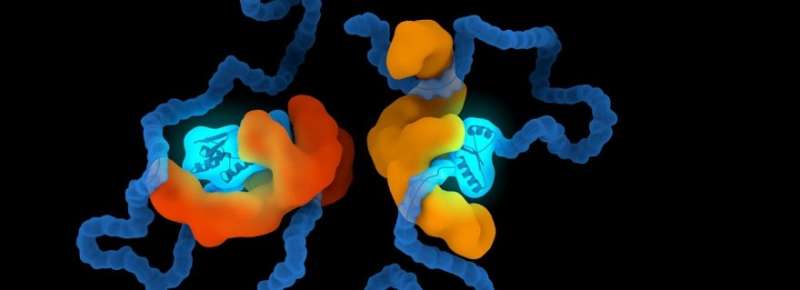Credit: Leiden University
Chaperones are a set of proteins that are specialised to assist proteins in the human body. They help proteins to fold to the right shape and protect them from adapting wrong shapes. The research group of Alireza Mashaghi, assistant professor and principal investigator at LACDR, investigates these structures. Vahid Satarifard, graduate student in the research group: "More than fifty diseases have been identified as being associated with protein misfolding. Many of them are highly devastating and increasingly prevalent." In proteopathic diseases, proteins can fold in the wrong way, becoming structurally abnormal. This causes them to become toxic or lose their normal function.
It is not well understood how chaperones help other molecules. It has been suggested that chaperones bind to proteins and this guides their folding. Mashaghi: "Chaperones are known to impose a constraint on their client proteins but whether those constraints have implications for protein folding is an open question. Some chaperones make contact with their client polypeptides and confine them internally; other hug their clients and confine them externally. We showed that these confinements can indeed affect the folding process. Certain shapes are less occupied while others are formed with an increased likelihood. We identified rules that govern this process." These rules show the likelihood that a protein adopts a certain shape under a given constraint.
Dealing with shapes
Mashaghi: "We asked whether we can define the topology for a linear molecule such as a protein or DNA. Topology deals with shapes. A core idea in this field is that if you take an object and deform it continuously, topological features do not change, but discontinuous deformation such as breaking an object changes its topology."
Mashaghi has a background in biophysics. "Pulling two ends of various proteins and DNA pieces is very much like pulling on a rope. For ropes, knot theory serves as a standard framework for defining shapes. What we and other researchers realised was that more than 97 percent of our proteins do not form a knot when you pull on them and thus fall into one shape class, namely the 'unknot." We asked ourselves whether we could define the topology for this 97 percent of the proteins and therefore be able to categorise them based on their shapes."
First, the research team simulated a polymer chain confined inside a sphere. Then, they investigated how this restraint can affect the structure. Satarifard: "In this study we used well-established polymer models with a new framework, focusing on shape rather than size and distances. This framework can give a novel view of structure based on contact arrangement. We assume that in biopolymers similar circuits exist, which would be rather flexible under some conditions."
Simulating a biomolecule
The research team also compared the shapes of an unconstrained chain with when it is constrained externally or internally by another molecule. Maziar Heidari, one of the graduate students, states: "This is important in biology because the functionality of a biomolecule is largely determined by its shape. For example, the way that a protein is folded and hides its binding sites can affect its functionalities and interactions with the other proteins."
The research team observed that the internal shape and folding organization substantially change as the chain undergoes different levels of confinement. Heidari: "This is interesting because this sheds light on the functionality and dynamics of the possible mechanisms and pathways through which an external molecule such as a chaperone folds and confines its client molecules. Additionally, our results are not limited to the study of the existing biological molecules. Our findings can inspire other scientists to design an artificial molecule or a drug that targets protein or genome folding processes."
Provided by Leiden University



















